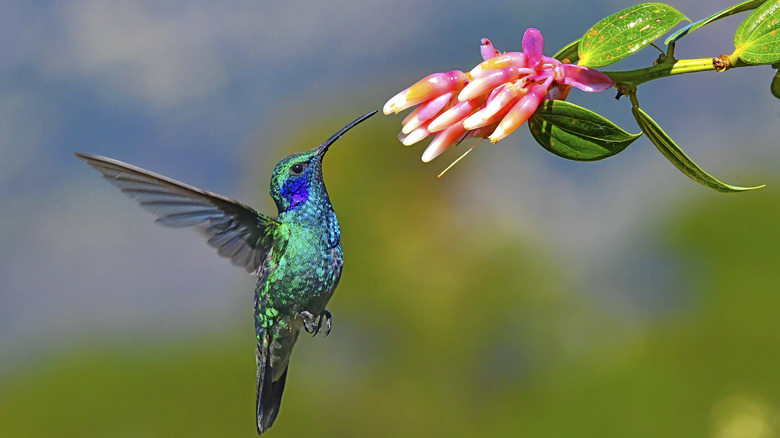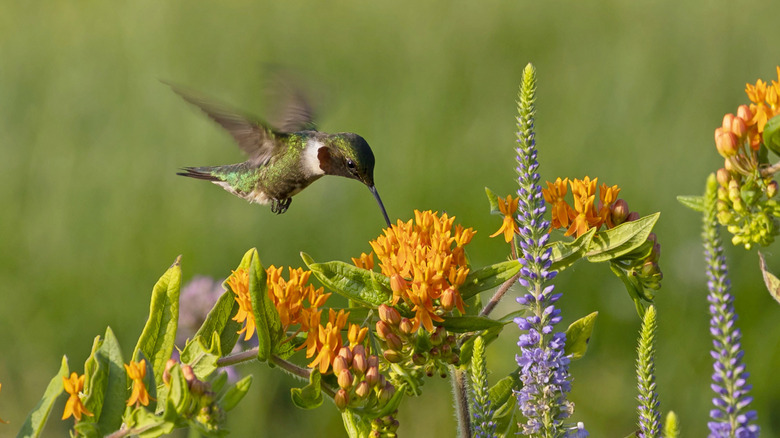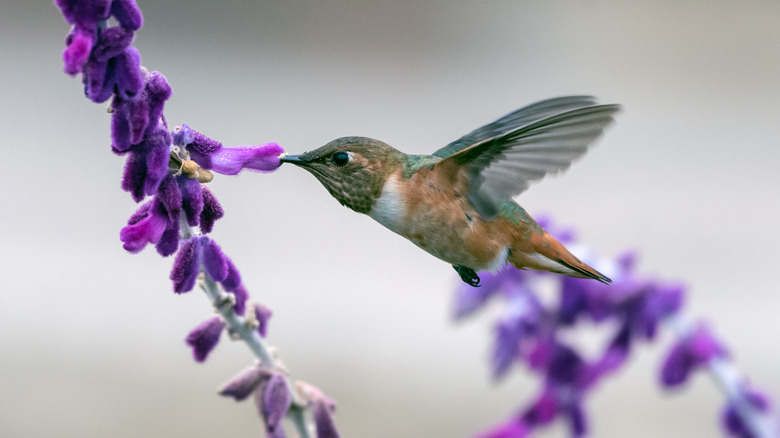Lure Beautiful Hummingbirds To Your Yard With This Genius Solution
Hummingbirds are definitely a special treat to see in the garden or in the wild. Because they're so tiny and move so quickly, they can be hard to spot, and they are most definitely not as ubiquitous as some other native bird species. If you're trying to attract hummingbirds to your backyard, there is no better way to do so than to plant native plants and wildflowers. Oftentimes, in an effort to attract hummingbirds, people go to the nursery section of their local big box store and purchase plants advertised as "pollinator friendly" or "hummingbird friendly." Unfortunately, we cannot trust big nurseries not to sell us invasive plants, and many of the flowering plants you come across, even if they're labeled "pollinator-friendly," may be invasive or hybridized.
Hummingbirds have evolved alongside their native plant peers for thousands of years. They do not have established relationships with non-native plants, and thus, these non-native plants do not provide the same ecological benefit or value. Additionally, invasive plants pose a serious threat to our native flora and fauna and should be avoided at all costs. It's as simple as going the extra mile and doing more research. If you're buying lots of flowers from your local nursery but hummingbirds are still avoiding your yard, consider whether those plants are sprayed with pesticides, hybridized and sterile, or just non-native.
Why planting native is essential for attracting hummingbirds
As mentioned above, native plants and hummingbirds have evolved together. Over the years, they have formed complex, interdependent, and mutually beneficial relationships. When a hummingbird feeds on a native wildflower, it pollinates that flower, which helps support the reproduction process and furthers the generation and genetics of that plant. Hummingbirds are considered a keystone species, meaning they are crucial to maintaining ecosystem balance because other species depend on them. When it pollinates a native wildflower, say, a wild blueberry, it produces fruit that will feed black bears, native birds, various animals, and even humans.
Additionally, it is estimated that nearly 25% of North America's 20,000 native plant species are at risk of extinction due to invasive species, habitat loss, and pesticides. According to the U.S. Department of Agriculture (USDA), using native plants in the home landscape can help to reverse the harsh effects of species loss. Aside from the many different reasons to plant native plants from an ecological perspective, hummingbirds are just more attracted to them. They are familiar with them, and if you want to attract hummingbirds to your yard, plant their favorite food. In doing so, you are not only benefiting the hummingbirds but also helping to counteract the devastating effects of invasive plants and habitat loss due to rampant development. Additionally, native plants are well acclimated to our ecoregion's climate, making them inherently drought tolerant and more resilient.
How to attract hummingbirds to your yard with native plants
Attracting native hummingbirds to your yard has everything to do with the plants that you plant. A lot of nursery plants that are advertised as pollinator friendly are actually sprayed with pesticides or bred to be sterile, which means they contain no pollen or seeds. Sterile plants provide zero benefit to native pollinators like hummingbirds who are looking for sweet, nectary food. Alternatively, you can visit your local native nursery, which sells exclusively native plants, and choose from various flowering plants that all provide a food source to hummingbirds and benefit other wildlife. If you don't know where to start, a great resource is biologist and native plant conservationist Doug Tallamy's Homegrown National Park Native Plants Finder.
Hummingbirds have an affinity for red-colored flowers, making it a great color to add to your garden. However, they are also attracted to blue, purple, orange, and white flowers. Flower shape also plays a significant role because their beaks only allow them to feed from tubular flowers. When choosing what native plants to select for your yard, consider your light, soil, and water requirements. Additionally, plant diverse flowering perennials and shrubs in large clusters to create continual foraging for hummingbirds. Some great options are tropical sage (Salvia coccinea), native milkweed varieties, coreopsis spp., liatris spp., coral honeysuckle (Lonicera sempervirens), and coral bean (Erythrina herbacea). You can also check out National Audubon Society's handy native plant database to discover native plants in your area.


